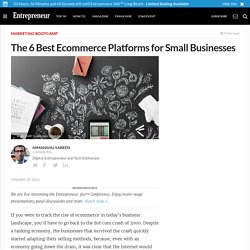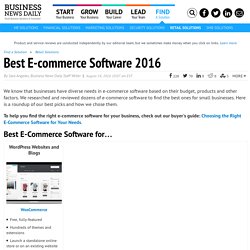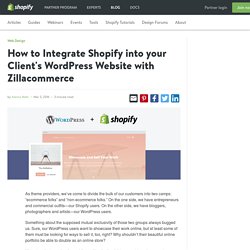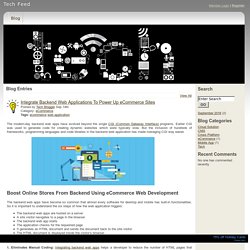

How Backend Web Applications Power Ecommerce Sites. I’ve explained how a website is displayed in a browser — the front-end technology — in “What HTML5 Means for Ecommerce Merchants,” “What CSS Means for Ecommerce Merchants,” and “What JavaScript Means for Ecommerce Merchants.”

In this post, I’ll address servers and backend applications. Brief History of Web Applications While my examples of HTML5 were valid, they were created by hand, which has several drawbacks. The primary one for ecommerce stores is that it would be difficult, if not impossible, to maintain the HTML, beyond a few dozen pages, for a complete site. In fact, since the early days of the Internet, people have used programs to help generate code for websites.
Today, backend web applications have evolved beyond single CGI programs to include hundreds of programming languages, frameworks, and code libraries that handle much of the coding for you. How Most Web Applications Work All of this happens in less than a second, ideally. Eliminates Manual Coding Generated Pages Can be Easier. The 6 Best Ecommerce Platforms for Small Businesses. Reader Resource We are live streaming the Entrepreneur 360™ Conference.

Enjoy main-stage presentations, panel discussions and more. Watch Now » If you were to track the rise of ecommerce in today’s business landscape, you’d have to go back to the dot com crash of 2000. Best E-Commerce Software for Small Business 2016. We know that businesses have diverse needs in e-commerce software based on their budget, products and other factors.

We researched and reviewed dozens of e-commerce software to find the best ones for small businesses. Here is a roundup of our best picks and how we chose them. To help you find the right e-commerce software for your business, check out our buyer's guide: Choosing the Right E-Commerce Software for Your Needs. Shopify has everything you need to launch, run and manage a successful e-commerce business.
Top 15 Free Shopping Cart Plugins For WordPress 2016. Months of planning, and weeks of preparation.

Your business plan is beginning to feel more graspable, but how exactly do we execute our business plan in the online ecosphere? The best way of selling products online is of course, through eCommerce. Physical goods, digital items or services, it all falls under the same category, and as business owners what we need to focus on, is delivering a solid and smooth shopping experience to our customers, across all categories of business. Dipping your feet in the eCommerce field can be scary at first, but platforms like WordPress have made the entry-level experience as easy as tapping a few buttons on your phone. Shopping carts and eCommerce platforms are nothing new to the market, there is a vast pool of choices to choose from, and it is without question a very tempting situation where we have to choose between a standalone platform, and a separate plugin addon for our exisiting publishing platform — such as WordPress.
How to Integrate Shopify into your Client's WordPress Website with Zil. As theme providers, we’ve come to divide the bulk of our customers into two camps: “ecommerce folks” and “non-ecommerce folks.”

On the one side, we have entrepreneurs and commercial outfits—our Shopify users. On the other side, we have bloggers, photographers and artists—our WordPress users. Something about the supposed mutual exclusivity of those two groups always bugged us. Sure, our WordPress users want to showcase their work online, but at least some of them must be looking for ways to sell it, too, right? Why shouldn’t their beautiful online portfolio be able to double as an online store? We sat on that question for a while, waiting for the right moment to make our not-so-crazy dreams a reality. We wanted our first big Themezilla release to be something worthy of the brand’s legacy, while adding our own stamp of Pixel Union ecommerce expertise. What is Zillacommerce? Simply put, Zillacommerce is the best way to sell online with WordPress. How does it work? What it all means. Tech Feed - Integrate Backend Web Applications To Power Up eCommerce Sites.
The modern-day backend web apps have evolved beyond the single CGI (Common Gateway Interface) programs.

Earlier CGI was used to generate code for creating dynamic websites which were typically slow. But the inclusion of hundreds of frameworks, programming languages and code libraries in the backend web application has made managing CGI way easier. The backend web apps have become so common that almost every software for desktop and mobile has built-in functionalities. So it is important to understand the six steps of how the web application triggers: The backend web apps are hosted on a server A site visitor navigates to a page in the browser The backend web app starts The application checks for the requested page It generates an HTML document and sends the document back to the site visitor The HTML document is displayed inside the visitor’s browser Ideally, all these functions happen in less than a second. 1. 2.
These benefits together can help you make your eCommerce store faster.